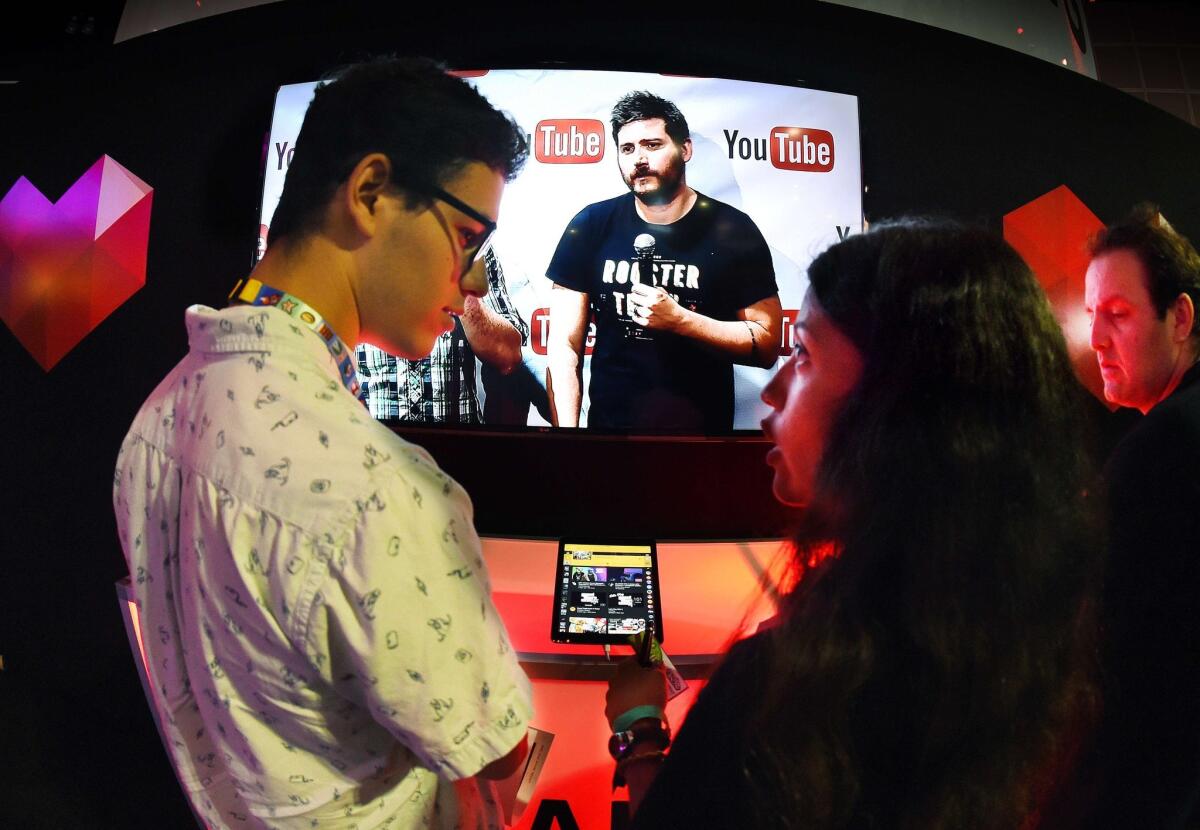Op-Ed: When your YouTube video becomes a corporate profit center

Visitors to the Electronic Entertainment Expo in downtown L.A.’s convention center on June 17 stand in front of a display promoting YouTube’s venture into game streaming called “YouTube Gaming.”
- Share via
Say it’s your wedding day. The ceremony’s over, and you’ve finished with the reception dinner. Uncle Charlie’s had too much to drink and is telling your college friends about the time he saw Foghat at the Hollywood Bowl in 1976. Suddenly the DJ takes the mike and announces it’s time for your first dance as a couple.
You and your beloved take the floor. The opening piano bars to your favorite song begin to play — “Up Where We Belong,” the eternal duet from Joe Cocker and Jennifer Warnes. (In this scenario, you have bad taste.) Your eyes begin to mist over as you dance to the song, while, off to the side, your father records the event for posterity on his cellphone.
A few days later, Dad uploads the video to YouTube. Because the song is plainly audible in the background, he adds the standard amateur disclaimer: “No Copyright Infringement Intended.” You’re a little worried that Universal Music Group, which owns the performance rights to the song, might force Dad to take the video down, but that doesn’t happen. Over the next few weeks, the video gets more than 5,000 views; Uncle Charlie gives it the thumbs up, and even Aunt Beatrice leaves a kind comment. You aren’t an expert in copyright law, but it seems Dad’s disclaimer has worked.
Hardly. What actually happened was this: YouTube’s automatic copyright detection service immediately flagged the video as potentially infringing. The company alerted UMG, offering it the option to pull the video or, alternatively, to start selling ads against it. UMG chose the latter. YouTube and UMG then split the revenue, with a small portion going to Cocker’s estate.
Everyone’s happy, right? You and your family get to relive your first dance; Google, the owner of YouTube, and Vivendi, the owner of UMG, get paid; and Cocker’s legacy is carried forward. The only problem is that a large corporate rights holder has turned one of the most intimate moments of your life into a profit center.
Since 2007, YouTube’s Content ID service has paid more than $1 billion to rights holders from such content, most of it generated by ordinary users. Often, these automatically identified videos include material that normally would be covered under the fair use or satire provisions of U.S. copyright law.
Questions of appropriation are always legally thorny; there’s no clear point at which audio background noise becomes part of the public domain. So YouTube’s content system plays it safe, automatically rendering judgment in favor of large media concerns. And once decisions are made, they are almost impossible to reverse.
Take the case of Warren Lain, a guitar teacher who, in 2011, uploaded an instructional video to YouTube featuring the chord progression to Radiohead’s “Reckoner.” The recording didn’t sound much like the original song, but YouTube’s sophisticated robots detected a match. YouTube alerted Warner Music Group, which then forced ads to be sold against the video, with the proceeds going to its publishing arm.
Lain appealed the decision but was overruled without explanation. He wrote numerous emails to Warner Music, and left several voice mails, but didn’t get a response. He even wrote a letter to Radiohead’s management, who told Lain they would look into the issue and get back to him. They never did.
“It was a minuscule amount of revenue,” Lain told me, “but it should be covered by fair use in the case of educational content.” Lain is of course free to upload his videos elsewhere — except that YouTube is 25 times more popular than the next largest hosting site. This monopoly power makes Google’s robots the de facto judges of contemporary Internet copyright infringement. “There’s no courtroom,” Lain said. “There’s just the code.”
When revenue isn’t minuscule, copyright holders take the offensive. Consider the popular “Let’s Play” phenomenon, in which YouTubers narrate so-called playthroughs of their favorite video games. These videos can be lucrative, attracting the attention of games manufacturers.
In 2014, for instance, Nintendo filed a copyright claim over a play-along from its popular “Zelda” franchise. The infringing media was less than a second long: a sound effect of Link, the game’s main character, unsheathing his sword. The merits of such claims are an unsettled area of copyright law, but in the court of YouTube, the decision always goes to the plaintiff. (The uploader didn’t bother to contest the 2014 decision.)
For many years, the ability to enforce copyright on the Internet was nil, a consequence of design choices made in the technology’s infancy that were intended to empower average users. As a result, almost all of what we currently consider Internet culture relies on appropriation to some degree. The best Web-based art genres — memes, mash-ups, play-alongs, even supercuts — all repurpose copyrighted media in unintended and sometimes brilliant ways. Techno-optimists praised such developments; they celebrated this “remix” culture. Some even wondered whether the concept of the copyright had become obsolete.
In 2015, this talk sounds foolish. If the ethos of the previous phase of the Internet was to empower users, the ethos of the contemporary phase is to extract value from them. Beginning in 2007, with the introduction of YouTube’s Content ID system, and proceeding slowly over the next few years, the interests of rights holders and technologists became aligned behind the scenes. Remix culture became a profit center.
Is this progress? Maybe. The automated gatekeepers at Google are safeguarding the ability of artists to earn royalties; perhaps this will lead to a flourishing of original creative work. Then again, many of the copyright decisions made by YouTube wouldn’t stand up in a court of law; perhaps Google’s monopoly is stifling progress by imposing unfair limits on the freedom of speech. It all depends on your perspective.
Stephen Witt is the author of “How Music Got Free: The End of an Industry, the Turn of the Century, and the Patient Zero of Piracy.”
Follow the Opinion section on Twitter @latimesopinion and Facebook
More to Read
A cure for the common opinion
Get thought-provoking perspectives with our weekly newsletter.
You may occasionally receive promotional content from the Los Angeles Times.










